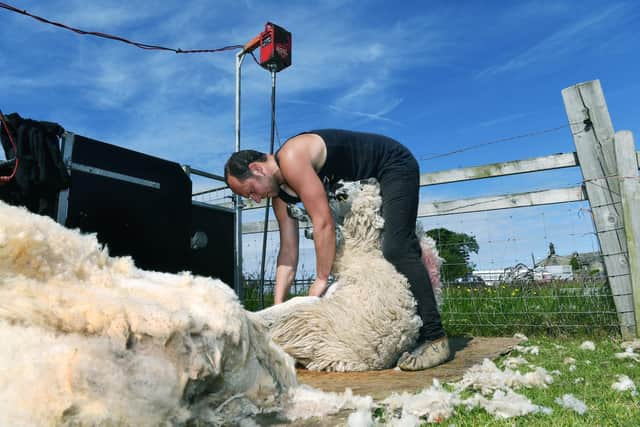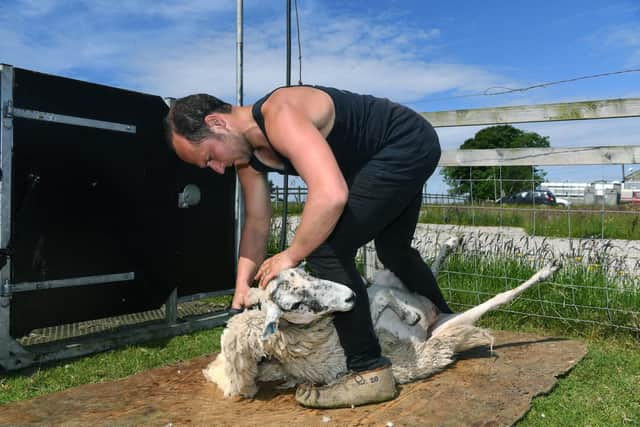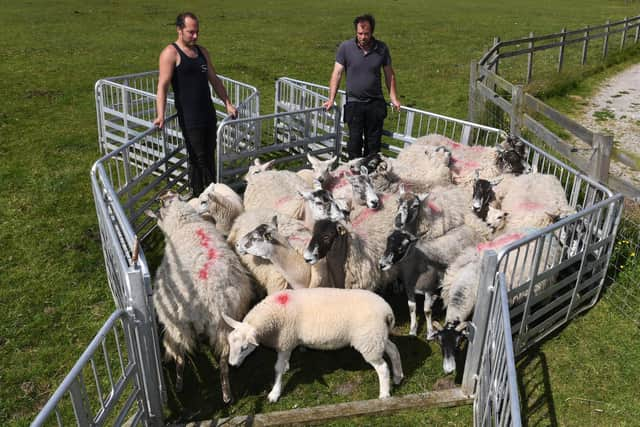Meet the rapid Yorkshire sheep shearer who is aiming to clip 8,000 in one season
Jimmy Harrison grew up at Hill Top Farm, Blubberhouses where his parents John and Karen have 900 hill sheep. His dad is a noted Dalesbred breeder. Jimmy worked for neighbour Robin Jackson as his first job after school where Robin had 1,000 hill sheep, but somewhat ironically Jimmy had hardly ever clipped before thinking of it as a career.
Jimmy said attending a British Wool-organised shearing course at Lindley Moor got him under way. He realised he was enjoying it and the course inspired him to set up in business nearly ten years ago.
Advertisement
Hide AdAdvertisement
Hide Ad“I’d tried the odd bit of clipping at home on dad’s farm and after the course held at Nicholas Houseman’s Prospect Farm I found that I just wanted to get better and better and get more numbers through.


“I’ve steadily got busier and busier and last year I sheared 3,500 sheep. I’d like to get to 8,000, that’s my goal, not for any other reason than I think that’s what I can get done. The shearing season starts in May and runs through to around mid-to-late July.
“It’s just technique. You learn through doing it, but you also learn from others. There used to be a shearing contractor come and do dad’s moors sheep and he gave me pointers as to where to get faster."
One of the main lessons Jimmy swiftly learned was how to deal with each animal.


Advertisement
Hide AdAdvertisement
Hide Ad“The main thing is to be as relaxed as you can with each one because the more you fight and the more you start losing your cool a little, the more difficult they can be. When I first started I’d get a bit that way. It was then a struggle because the sheep sense it and things just get worse.
“I’m now really calm, don’t let anything appear to bother me and nine times out of ten they’re really calm too. I’ll deal with any kind of sheep. I’m not bothered what they are.
“The most difficult ones are Cheviots and I do a lot of them. I sometimes think that’s why people get me to do them, because I know how to handle them. I do one farm where I do hundreds and hundreds of Cheviots. You sit them down and I’m not kidding, it’s like trying to keep hold of a suckler calf. They never stop kicking, especially the hoggs. It’s just the breed’s temperament. It doesn’t like being sheared."
Jimmy said that while his main trade is with larger flocks of commercial breeds such as Mules and Texel-cross he also clips a reasonable number of what are referred to as hobby farmers’ sheep. These customers seem to go for clipping a bit earlier in the season.


Advertisement
Hide AdAdvertisement
Hide Ad“The ones I do are Ryelands and ‘owt fluffy’. I start off with the hobby farmers, some of which might only have two or three as pets. It gets my season off to a steady start as for some reason they like theirs clipping in early May. They always seem to want me early, which is good for me.
“Big woollier sheep can be a bit more difficult than your average Mule or Texel-cross because the wool you’re dealing with is generally stickier, and because there’s a lot of it the animal can get fed up if you’re over long."
Jimmy said that clipping speed isn’t something with which he has a problem, but it hasn’t led him towards entering sheep shearing competitions such as at next month’s Great Yorkshire Show.
“I’m not really into competitions. Some say I’m fast enough to enter and do well, but the other side of me says that I don’t get paid to do it, so I’d rather go where I do get paid.
Advertisement
Hide AdAdvertisement
Hide Ad“In an hour I can get 35-40 sheared and I’m a tidy shearer. I have pride in my work. I like to get into a rhythm and keep going. Last night I was clipping at one farm where I was only meant to be doing 100 and the farmer said there were only another 100 left to do. I was in such a good rhythm that I had the rest done by about quarter to ten."
Jimmy said the clipper he most admires is Stephen Robinson of Knaresborough.
“I worked with him and watched him. Stephen is one hell of a clipper. He never changes his speed all day long. If I get as good as Stephen, I’ll be happy. It’s all about getting into that rhythm and having the right technique."
Having the right equipment is another vital ingredient to any shearer and Jimmy said he has a system that works well for him.
Advertisement
Hide AdAdvertisement
Hide Ad“You need a good reliable handpiece and machine, as well as a reliable set of cutters and combs. I’m always looking at what’s new on the market. If it’s a busy day, as it is most days, I’ll have two handpieces set up so that I can get on quickly, and so that I can choose which is best at the time.
“I use an electric Lister Nexus solid shaft and a Horner Longhorn 12-volt machine with an Icon handpiece. If it’s a long day I prefer the Lister because it’s faster. If it’s only a little packet and easy to get to I’ll use my Longhorn as it’s easier to set up."
Jimmy said that demand for clippers is certainly there and that the demand appears to be growing for commercial sheep.
“I travel all the way over to Scarborough and up to Northallerton. The nearer you get to the coast there is a shortage of clippers. I am getting a lot more Mule sheep and Texel-cross, because they’re worth more at market and need to look good.”
